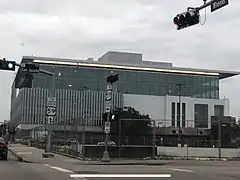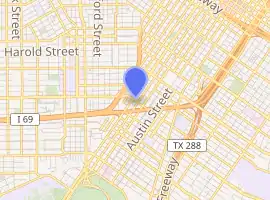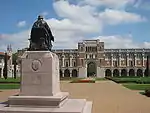Rice Innovation District
The Rice Innovation District (RID) is a technology park and innovation district in Midtown Houston which was established as a joint initiative between Rice University and the City of Houston. The first building, the Ion, was originally a Houston's first Sears department store until it closed in 2018.[1]
| Rice Innovation District | |
|---|---|
 The Ion construction as of December 2020. | |

| |
| General information | |
| Town or city | Houston, Texas |
| Country | United States |
| Coordinates | 29.73396°N 95.38259°W |
| Current tenants | Chevron Greentown Labs Microsoft |
| Construction started | 2019 |
| Inaugurated | 2021 |
| Owner | Rice University |
| Landlord | Rice Management Company |
| Grounds | 16 acres |
| Website | |
| ionhouston houinnovate | |
History
Rice University has owned the land where the original Sears building sits for most of its store life. In 2018, Sears announced it would be closing the store as part of an effort to close unprofitable stores. Rice purchased the remaining portion of Sears' lease as well as a few surrounding acres to bring the land total to over 16 acres.[2] They also announced they had plans for future use of the land.[1]
Mayor Sylvester Turner made a push to open a high-tech innovation district as a priority. He cited Rice, the University of Houston and the University of Texas as potential institutes to lead the district.[1]
In early 2019, Rice announced the site where the original stood along with its surrounding area would be transformed into an innovation district. "The Ion" was the name selected for the former Sears building. President of Rice, David Leebron stated "We chose the name Ion because it's from the Greek ienai, which means 'go'. We see it as embodying the ever-forward motion of discovery, the spark at the center of a truly original idea. It also represents the last three letters in many of the words that define the building's mission, like inspiration, creation, acceleration and innovation."[3]
Project manager HR&A Advisors, with offices in New York and various other cities, is overseeing the design and construction, assisting with the master plan for the innovation district as well as the development strategy.[4][5] HR&A has prior experience in Houston with Hurricane Harvey recovery and Buffalo Bayou Park.[6][7] New York-based companies James Corner Field Operations and SHoP Architects are leading the project's design.[8]
Community Benefits Agreement
Since The Ion's groundbreaking in July of 2019, students of Rice University and other Houston-area universities have advocated for a Community Benefits Agreement (CBA), a contractual agreement between a developer and a community coalition.[9] In a January 2020 open letter, representatives of 17 different Rice student organizations advocated for the Rice Management Company (RMC) to enter into a CBA with the Houston Coalition for Equitable Development without Displacement (HCEDD).[10][2] Without such an agreement, there are widespread concerns about a lack of community accountability that will result in the perpetuation of problems seen in other cities' tech hubs.[9] According to Sam Dike, Manager of Strategic Initiatives, RMC has chosen to create a Community Benefits Working Group made up of up to fifteen members to help provide input on an agreement between RMC and the City of Houston.[11]
Houston Coalition for Equitable Development Without Displacement (HCEDD)
The Houston Coalition for Equitable Development without Displacement, also known as HCEDD, formed in October and held its first community meeting in November of 2019 in pursuit of a community benefits agreement with Rice Management Company.[12] The Ion's executive director at the time, Gaby Rowe, was invited to give a presentation on the innovation district and field questions before the public forums held by Rice and the City of Houston in September of 2020.[13] In addition to a CBA, student members of the coalition seek a Racial Equity Impact Assessment, as well as public transparency about Rice's community engagement efforts and neighborhood survey.[14] Over the course of several months of public meetings, the coalition came to make up over twenty organizations, formed working groups, and elected a negotiation team.[15][16] HCEDD has also held public workshops about the research behind the CBA process with Dr. Murtaza Baxamusa, known for his research on community benefits agreements.[17]
City of Houston
Shortly after a January 20 open letter from a Rice student coalition demanding a CBA with the Houston Coalition for Equitable Development without Displacement and the introduction of a January 27 Student Association resolution, Mayor Turner on January 29 wrote to the president of Rice's Student Association that he has told Andy Icken, the city's chief development officer, to negotiate a "CBA" with Rice Management Company and coordinate community input.[18][12] Such an agreement between a municipality and a developer is traditionally described as a development agreement rather than a community benefits agreement, which by definition must include a community coalition.[15] The City of Houston facilitated online informational webinars alongside RMC in September and October of 2020 on job-training, housing affordability, and hiring opportunities.[19]
Rice Student Association Senate Resolution #8
The Rice University Student Association Senate passed a resolution on February 17, 2020, in support of a community benefits agreement process for the Innovation District.[15] The resolution states that a CBA is "project‐specific contract between developers or cities and community coalitions. CBAs are legally binding, enforceable agreements that call for a range of benefits to be produced by the development project. They allow community groups to have a voice in shaping a project, to press for community benefits that are tailored to their particular needs, and to enforce the developer's promises," and asks that RMC make HCEDD an equal party in the CBA negotiation process, as well as create processes for public openness and transparency.[20] Allison Thacker and Ryan LeVasseur, RMC's president and director of real estate respectively, argued against the resolution, stating that HCEDD does not have legal authority to enter into a CBA contract and that the large coalition represents a substantive portion, but not the entire community.[21] Students also shared that RMC "threatened to disown the [Student Association] as a legitimate campus body if the SA Senate passed a resolution supporting the HCEDD as a signatory party in the CBA."[20]
Funding
Rice Management Company plans to invest $100 million in renovation for The Ion.[2] The Ion falls within Tax Increment Reinvestment Zone (TIRZ) #2, and RMC is seeking $75M in cost reimbursement from City of Houston taxes that are expected as a result of development on properties within the innovation district.[22] The Ion falls within a Texas Census block group that is both a Texas Enterprise Zone and an Opportunity zone, qualifying it for certain financial incentives at the local, state, and federal levels.[23][24] These can also result in tens of millions of dollars in cost savings for the developer through taxpayer subsidies over the course of a decade.[25]
Texas Enterprise Zone
Enterprise Zones are census block groups in Texas with a poverty rate at or above 20%. They are a way to collect various local and state incentives together to spur innovation in order to revitalize an area that is considered distressed. Local benefits may include but aren't limited to tax abatement, permitting fee waivers, publicly-owned buildings transferred below market cost, and low-interest loans. State benefits may include state sales and use tax refunds, depending on the level of investment and the number of jobs created.[23]
Opportunity Zone
This federal program is also for areas that are considered distressed, providing tax benefits such as tax abatement to private investors in hopes of creating economic development and jobs in those areas.[26] These census tracts were nominated by Governor Greg Abbott, seeking to address issues including risk of economic disrupters such as hurricanes, relatively low population density, and persistent unemployment. A 2020 report found that many opportunity zone beneficiaries are real estate investors who were likely to still do the development even without taxpayer subsidies, rather than companies that are creating jobs.[27]
Facilities
The Ion along with the surrounding innovation district plans to be a center where businesses, entrepreneurs and students combine.
Academics
Rice University's Glasscock School of Continuing Studies was the first school to announce coursework at the Ion, including data science and financial services.[28]
Tenants
- Aerospace Innovation Hub (NASA partnership)[29]
- Chevron Technology Ventures[30]
- Greentown Labs
- Microsoft[31]
Campus
List of buildings
| Name | Photograph | Year Built | Architect | Description |
|---|---|---|---|---|
| The Ion |  |
2021 | SHoP Architects | The original building of the innovation district is The Ion. Technology companies lease office space in the building and have access to entrepreneurs and the student body of Rice University and other invited institutions. Students attend classes in the building and aspiring entrepreneurs showcase ideas. |
| Greenworks Labs |  |
2021 | Climate tech incubator that seeks to innovate ways to improve the climate. | |
| Ion Garage | 2022 | Parking garage with ground level retail | ||
References
- "Iconic Sears in Houston closes its doors after 79 years". ABC 13. August 19, 2020. Retrieved August 19, 2020.
- Britto, Brittany (2020-01-22). "Rice students band together in hopes of protecting Third Ward amid plans to develop innovation district". HoustonChronicle.com. Retrieved 2020-12-28.
- Harms, Natalie (August 19, 2020). "Rice University transforms iconic Sears building into innovation hub". Culture Map. Retrieved August 19, 2020.
- "The Ion and South Main Innovation District Master Plan and Development Strategy". HR&A. Retrieved 2020-12-30.
- "Real Estate Development Advisory Archives". HR&A. Retrieved 2020-12-30.
- "Houston Rebuilds". HR&A. Retrieved 2020-12-30.
- "Buffalo Bayou East Sector Investment Framework and Master Plan". HR&A. Retrieved 2020-12-30.
- The Ion Houston. "The District". The Ion Houston.
- "Rice University-led Ion innovation district breaks ground". HoustonChronicle.com. 2019-07-19. Retrieved 2020-12-28.
- HCEDD, Students for (2020-01-21). "Rice University Students to President David Leebron and Board of Trustees: Not In Our Name". Medium. Retrieved 2020-12-28.
- "Sam Dike | Rice Management Company | Rice University". investments.rice.edu. Retrieved 2020-12-30.
- "Ion Community Benefits Agreement shifts to City of Houston". The Rice Thresher. Retrieved 2020-12-28.
- "Rice Management, city leaders seek input on Midtown's Innovation District". HoustonChronicle.com. 2020-09-29. Retrieved 2020-12-28.
- "Student-led coalition to Rice: Be a better neighbor as you and your partners develop The Ion [Opinion]". HoustonChronicle.com. 2019-08-24. Retrieved 2020-12-28.
- "It's time for Rice Management Company to get serious about a Community Benefits Agreement". The Rice Thresher. Retrieved 2020-12-28.
- "Protect the Tre with a Community Benefits Agreement". www.houstoncba.org. Retrieved 2020-12-28.
- Baxamusa, Murtaza (March 2008). "Empowering Communities through Deliberation The Model of Community Benefits Agreements". Journal of Planning Education and Research. 27: 261–276.
- Britto, Brittany (2020-01-29). "In victory for students, community groups, Mayor pledges city will strike deal ensuring innovation district provides far-reaching benefits". HoustonChronicle.com. Retrieved 2020-12-28.
- "In Houston's Third Ward, Community Groups are Fighting for Equitable Development". The Texas Observer. 2020-11-18. Retrieved 2020-12-28.
- "Senate passes revised resolution in support of CBA between Rice Management and City of Houston". The Rice Thresher. Retrieved 2020-12-28.
- "Rice Management Company defends Ion". The Rice Thresher. Retrieved 2020-12-28.
- MIDTOWN REDEVELOPMENT AUTHORITY/TIRZ#2 BOARD OF DIRECTORS MEETING October 29, 2020 (PDF) (Report). Midtown Redevelopment Authority. 2020.
- "Texas Enterprise Zone Program". gov.texas.gov. Retrieved 2020-12-30.
- "Opportunity Zones". gov.texas.gov. Retrieved 2020-12-30.
- Schuetz, R. A. (2018-12-17). "Are federal 'opportunity' tax breaks going to right places?". HoustonChronicle.com. Retrieved 2020-12-30.
- "Opportunity Zones". gov.texas.gov. Retrieved 2020-12-30.
- Schuetz, R. A. (2020-06-18). "Property investors, not job creators, seen benefiting most from Opportunity Zones". Chron. Retrieved 2020-12-30.
- Matthews, Chris (January 7, 2020). "Houston innovation hub unveils first academic partnership". American City Business Journals. Retrieved August 20, 2020.
- "The Ion awarded $1.4M to launch Aerospace Innovation Hub". Rice News and Media Relations. October 8, 2020. Retrieved December 26, 2020.
- "The Ion Welcomes Chevron as First Tenant and Program Partner". PR Newswire. January 7, 2020. Retrieved August 20, 2020.
- "Microsoft announces lease in rising Houston innovation hub". Innovation Map. December 18, 2020. Retrieved December 26, 2020.

